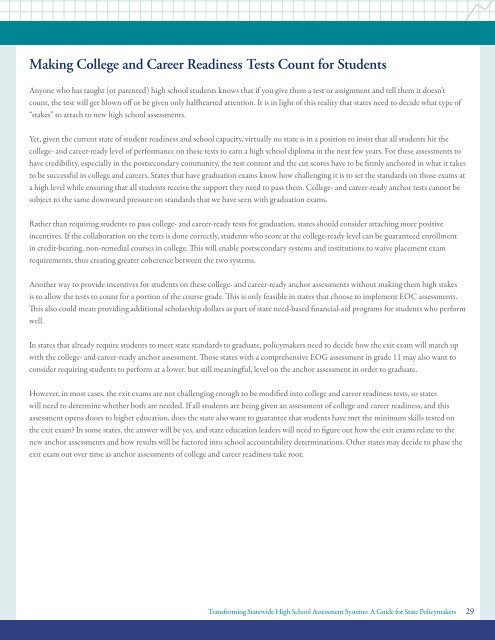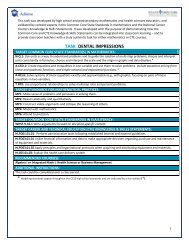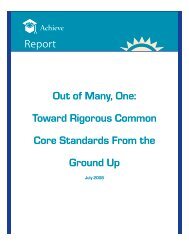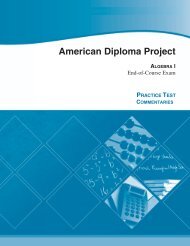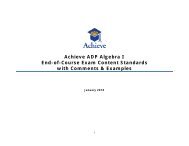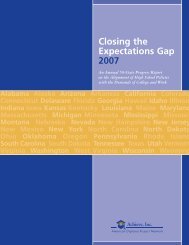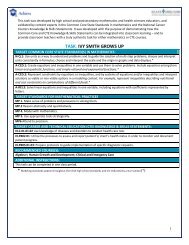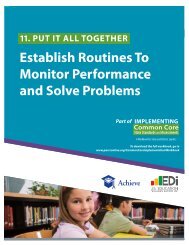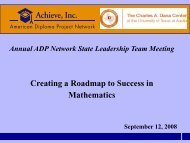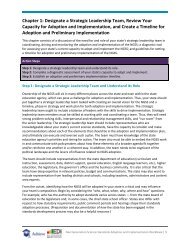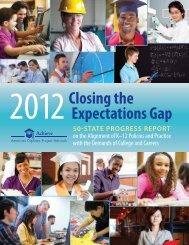Transforming Statewide High School Assessment Systems: - Achieve
Transforming Statewide High School Assessment Systems: - Achieve
Transforming Statewide High School Assessment Systems: - Achieve
You also want an ePaper? Increase the reach of your titles
YUMPU automatically turns print PDFs into web optimized ePapers that Google loves.
Making College and Career Readiness Tests Count for StudentsAnyone who has taught (or parented) high school students knows that if you give them a test or assignment and tell them it doesn’tcount, the test will get blown off or be given only halfhearted attention. It is in light of this reality that states need to decide what type of“stakes” to attach to new high school assessments.Yet, given the current state of student readiness and school capacity, virtually no state is in a position to insist that all students hit thecollege- and career-ready level of performance on these tests to earn a high school diploma in the next few years. For these assessments tohave credibility, especially in the postsecondary community, the test content and the cut scores have to be firmly anchored in what it takesto be successful in college and careers. States that have graduation exams know how challenging it is to set the standards on those exams ata high level while ensuring that all students receive the support they need to pass them. College- and career-ready anchor tests cannot besubject to the same downward pressure on standards that we have seen with graduation exams.Rather than requiring students to pass college- and career-ready tests for graduation, states should consider attaching more positiveincentives. If the collaboration on the tests is done correctly, students who score at the college-ready level can be guaranteed enrollmentin credit-bearing, non-remedial courses in college. This will enable postsecondary systems and institutions to waive placement examrequirements, thus creating greater coherence between the two systems.Another way to provide incentives for students on these college- and career-ready anchor assessments without making them high stakesis to allow the tests to count for a portion of the course grade. This is only feasible in states that choose to implement EOC assessments.This also could mean providing additional scholarship dollars as part of state need-based financial-aid programs for students who performwell.In states that already require students to meet state standards to graduate, policymakers need to decide how the exit exam will match upwith the college- and career-ready anchor assessment. Those states with a comprehensive EOG assessment in grade 11 may also want toconsider requiring students to perform at a lower, but still meaningful, level on the anchor assessment in order to graduate.However, in most cases, the exit exams are not challenging enough to be modified into college and career readiness tests, so stateswill need to determine whether both are needed. If all students are being given an assessment of college and career readiness, and thisassessment opens doors to higher education, does the state also want to guarantee that students have met the minimum skills tested onthe exit exam? In some states, the answer will be yes, and state education leaders will need to figure out how the exit exams relate to thenew anchor assessments and how results will be factored into school accountability determinations. Other states may decide to phase theexit exam out over time as anchor assessments of college and career readiness take root.<strong>Transforming</strong> <strong>Statewide</strong> <strong>High</strong> <strong>School</strong> <strong>Assessment</strong> <strong>Systems</strong>: A Guide for State Policymakers 29


